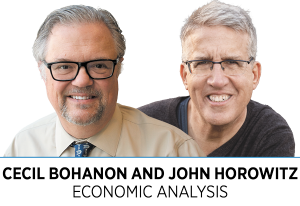Subscriber Benefit
As a subscriber you can listen to articles at work, in the car, or while you work out. Subscribe Now Where is the U.S. economy going, and what should government do to ensure prosperity? A critical player is the Federal Reserve, whose primary job is maintaining a low and stable inflation rate. The Federal Reserve has more or less established a 2% long-run inflation target. In our opinion, it would be very unwise for the Fed to raise that target, and there is little evidence it intends to do so. So, how is the Fed doing?
Where is the U.S. economy going, and what should government do to ensure prosperity? A critical player is the Federal Reserve, whose primary job is maintaining a low and stable inflation rate. The Federal Reserve has more or less established a 2% long-run inflation target. In our opinion, it would be very unwise for the Fed to raise that target, and there is little evidence it intends to do so. So, how is the Fed doing?
The primary way the Fed tries to maintain low and stable inflation is through the target rate it sets for Fed Funds, which is the interest rate for overnight lending between U.S. banks. This provides a benchmark for other interest rates in the economy.
Before the 2008 financial crisis, the Fed Funds rate was 5.25%. To forestall an economic depression during the 2008 financial crisis, the Fed lowered the rate to near zero in 2008 and kept the rate below 2.5% until September of last year. The fear that these ultra-low rates would trigger inflation did not materialize for over a decade. From the fall of 2008 until the spring of 2021, the annual inflation rate never exceeded 4%. Inflation broke 4% in April 2021, then more than doubled, peaking at 9% in August 2022.
The Fed started raising the Fed Funds rate in the spring of 2022 to quell rising inflation and has stayed on that course since then. The Fed Funds rate today stands at 5.33%. Inflation has come down and hovers around 3%, well below its peak but not yet to the 2% target.
To determine if the Fed should raise rates to lower inflation, we should look at what people expect inflation rates to be in the future. The difference between the interest yield on the regular five-year U.S. Treasury bond and the inflation-indexed five-year U.S. Treasury bond is an indicator of what market participants expect inflation to be in the next five years. This difference has been below 2.5% since March and has steadily declined. In October, it was 2.14%. In addition, the yield on the unindexed five-year U.S. Treasury is 4.8%—the highest it has been since before the 2008 crisis.
Despite our tendency to be inflation hawks and our disdain for discretionary monetary policy, since people’s expectations about inflation are about 2% and are falling, we think the Fed should keep rates where they are and not raise them.•
__________
Bohanon and Horowitz are professors of economics at Ball State University. Send comments to [email protected].
Please enable JavaScript to view this content.
